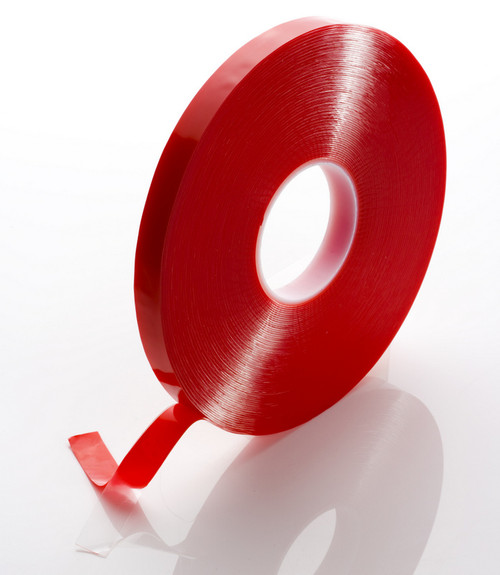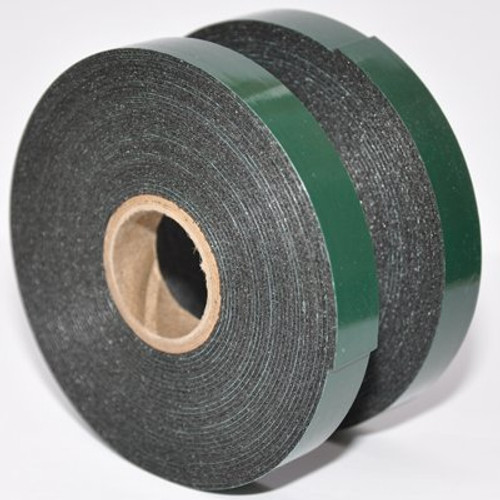Description
This tape is used widely within the: Point of Sale (POS) and signage industries for demanding applications.
Consequently, this adhesive gel tape forms extremely strong bonds to high energy surfaces such as: glass, metal, and plastics, while having a very good aging, UV, and temperature resistances.
Our Gel Tapes will create a permanent reliable bond for either: indoor or outdoor applications, and their structure will allow for differential rates of expansion - if bonding dissimilar materials.
This thick foamed structural acrylic gel tape is ideal for bonding: glass, clear plastics and other applications which require an invisible bond line. These foams are: soft, tacky and conformable, and acts as a very good seal and bonding tape. Industries where this tape has ideal application uses include; but, not limited to: solar energy industry, glass partitions industry, windows industry, doors and safety glass manufacture.
Design factors & tape usage information
Thickness of tape to be used
The thickness of tape selected should depend on the following factors
- The rigidity of the substrates to be bonded
- The irregular nature of the two surfaces
- The amount of pressure to be applied to ensure good adhesive 'wet out'
- The mismatch of the two surfaces must be less than half the tape thickness to ensure good surface contact under pressure
- To ensure good adhesive 'wet out' a test piece of the substrate - that has an uneven surface - should be bonded to a clear acrylic under pressure. This will allow you to see what the contact area is
- Semi-flexible materials such as some PVC materials, with a memory need thicker tape to distribute the stress resulting from the materials memory
- Choosing the correct thickness of tape will ensure that the ultimate bond will be achieved
How much tape do you need to use in an application?
How much tape you need to use depends on a number of factors. These factors include:
- What are the substrates to be bonded?
- What is the load bearing, is it static or dynamic?
- Is the material subjected to exposure to extremes of weather, etc...?
- Is there constant force or spasmodic forces affecting the bond?
To help you understand what is right for you, as a general rule 0.025m2/kg of tape should be used to hold 1kg in a static situation. However, this will vary from application to application.
There is a safety factor built into this equation; but, you should always test the tape in your own application thoroughly.
This foamed acrylic tape will hold substantial loads, but a safety factor is important in: critical structural applications.
Features & benefits information
This tape has several key features & benefits. These include:
- That this tape isolates dissimilar metals
- That it is virtually invisible
- That it has a high temperature tolerant
- That it is solvent /moisture resistant
- That it has a high cleavage strength
- That it leaves surface intact
Along with this, this structural acrylic gel tape has:
- Excellent high performance capabilities
- High resilient performance in all weather conditions
- Load and stress properties, which spread both of these across the plane of the bond - there are no stress points that arise with mechanical fixings
- The ability to stop metal fatigue and mechanical degradation - that you get with fixings such as screws, nuts and bolts
- Properties such as: vibration, dampening, shock, absorption, sealing, thermal expansion or contraction to take up conformability
- Aesthetic enhancement - no screw heads are visible.
- Has great invisible fixing and bonding properties
- Properties that help to reduce re-finishing work, touching up and clean up time which are required with other forms of bonding fixing
- The ability to be: quick to use, clean, safe, economic, and improves productivity
- The ability to not damage substrates to be bonded - no mechanical fixing punctures / holes
- Properties which help: stop rusting, to allow a complete seal to be achieved
Advantages of a Viscoelastic foamed acrylic gel tapes
Our: foamed acrylic tapes, are made of a: viscoelastic acrylic copolymers and monomers which have a filler comprising of glass microspheres.
The tape is extruded and the curing process is by ultra violet (UV) light, this allows very thin foams to be produced from 0.25mm to thicker foams - up to 3mm thick foam tape - using the same process. The foam used in this tape is naturally tacky (sticky) and has good adhesive properties.
Due to the strength of this type of tape it benefits you, as in most cases does not require holes to be drilled, no rivets to head, epoxies to cure, or weld distortion.
Along with this, these tapes eliminates corrosion between dissimilar metals, and compensate for thermal expansion differences, while providing vibration and sound dampening properties.
Our gel tapes are ideal when: an immediate adhesion is required, you need to bond dissimilar materials, seal joints or just bond thin substrates.
What makes our Viscoelastic foamed acrylic gel tapes bond so well?
The viscoelastic properties allows the adhesive to flow into the microscopic surface of the materials being bonded. The adhesive bond is very strong when there is good 'wet out', enabling maximum adhesive contact under pressure with the substrates to be bonded.
Abrading the surface to be bonded actually improves the strength of the bond. This abrading creates a rough surface for a greater area for the adhesive to key into.
Along with this the elastic characteristics of the foam, give it very good internal cohesive strength to support loads in both: static and dynamic shear. This also gives the foam very good peel adhesion strength, and is soft and very flexible which means it has great conformability.
The foam also has very good elasticity due to the high internal cohesive strength of the foam, and will radius well, (go around curves).
Application information
- Ensure that the surfaces to be bonded are completely clean and free from dust and grease
- The surfaces to be bonded should be dry and free from any loose particles
- The best cleaning medium is a solvent such as isopropyl alcohol applied with a clean cloth or tissue
- To attain the optimum bond sufficient pressure should be applied to the surface area to be bonded. To ensure good adhesive 'wet out' typical pressure should be 15psi = 100kpa
- The adhesive is pressure sensitive and best results are achieved with maximum surface contact under pressure
- 50% of the optimum bond strength will be achieved after 20 minutes. 90% is achieved after 24 hours. 100% is achieved after 72 hours.
- Avoid significant load bearing to the bond directly after application
- Recommended application temperature +20°c to +36°c
- Minimum application temperature should not be below +10°c
- Certain surfaces will require priming or sealing such as porous surfaces - plaster & concrete, also absorbent surfaces such as wood & fabrics
- Metals with oxidised surfaces such as aluminium, copper & brass may need priming. Low energy surfaces such as polypropylene plastics containing aggressive plasticisers may also need treatment
Technical information
| Description | Unit of measurement | Technical Value | ||
|---|---|---|---|---|
| Carrier | Acrylic Foam | |||
| Adhesive | Acrylic | |||
| Colour | Clear | |||
| Thickness | mm | ins | 1.0(±0.1) | 0.039 (±0.004) |
| Release liner | Red PE / Paper | |||
| 180° Peel Adhesion ASTM D-3330 |
g/25mm | lbs/in | 2700 | 6.0 |
| Tensile adhesion (T-Block Test) ASTM D-897 |
g/cm2 | lbs/in2 | 7030 | 100 |
| Density of foam | kg/m3 | lb/ft3 | 1000 | 62 |
| Dynamic Sheer ASTM D-1002 |
g/cm2 | lbs/in2 | To Stainless Steel, Room temp after 24 hours | |
| 4900 | 70 | |||
| Temperature resistance short term | °C | °F | 150 | 302 |
| Temperature resistance long term | °C | °F | 90 | 194 |
| Low temperature resistance | °C | °F | -40 | -40 |
| U.V Resistance | Good | |||






